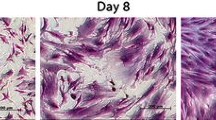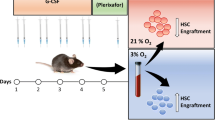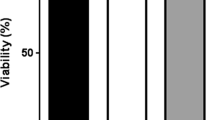Abstract
Reports on the isolation of mesenchymal stromal cells (MSCs) from granulocyte colony stimulating factor mobilized peripheral blood (G-CSF-mobilized PB) using regular culturing techniques are controversial. Enrichment techniques such as CD133 isolation have increased the success rates. CD271 is a wellknown marker for enrichment of MSCs from bone marrow (BM). In the present study, we aimed to find out whether CD271 enrichment can help isolation of MSCs from G-CSF-mobiiized PB. Five G-CSF-mobilized PB samples were collected from the remnant parts of the bags used for BM transplantation. Five BM samples were used as the control. Mononuclear cells (MNCs) from both resources were collected and underwent magnetic sorting for CD271-positive cells. The isolated cells were cultured, undergoing flowcytometry and differentiation assays to determine if they fulfill MSCs characteristics. CD271-positive portion of G-CSF-mobilized PB did not yield any cell outgrowth but the BM counterpart could successfully form MSC colonies. Although the percentage of CD271+ cells showed no difference between BM-MNCs and G-CSF-mobilized PB-MNCs, hematopoietic markers such as CD45, CD34 and CD133 composed a higher percentage of CD271-positive cells in the G-CSF-tnobiiized PB group. Results obtained indicated that CD271 enrichment does not help isolation of MSCs from G-CSF-mobilized PB. In this source, almost all of the CD271+ cells are from hematopoietic origin and the frequency of MSCs is so low that possibly during the process of cell isolation most of them are lost and the isolation fails.
Similar content being viewed by others
Abbreviations
- BM:
-
bone marrow
- G-CSF-mobilized PB:
-
granulocyte colony-stimulating factor mobilized peripheral blood
- MNC:
-
mononuclear cell
- MSC:
-
mesenchymal stromal cell
References
Vassaghi A., Dehghani A., Khademalhosseini Z., Maharlooei M.K., Monabati A., Attar A. 2013. Parameters that influence the isolation of multipotent mesenchymal stromal cells from human umbilical cord blood. Hematol. Oncol. Stem Cell Ther. 6, 1–8.
Ahrari I., Purhabibi Zarandi N., Khosravi Maharlooei M., Monabati A., Armin A., Ahrari S. 2013. Adipose tissue derived multipotent mesenchymal stromal cells can be isolated using serum-free media. Iran. Red Crescent Med. J. 15, 324–329.
Attar A., Langeroudi A.G., Vassaghi A., Ahrari I., Maharlooei M.K., Monabati A. 2013. Role of CD271 enrichment in the isolation of mesenchymal stromal cells from umbilical cord blood. Cell Biol. Int. 37, 1010–1015.
Hadaegh Y., Niknam M., Maharlooei M.K., Tavangar M.S., Attar A., Aarabi A.M., Monabati A. 2013. Characterization of stem cells from the pulp of unerupted third molar tooth. Indian. J. Dent. Res. 24, 78–85.
Lund T.C., Tolar J., Orchard P.J. 2008. Granulocyte colony-stimulating factor mobilized CFU-F can be found in the peripheral blood but have limited expansion potential. Hematologica. 93, 908–912.
He Q., Wan C., Li G. 2007. Concise review: Multipotent mesenchymal stromal cells in blood. Stem Cells. 25, 69–77.
Villaron E.M., Perez-Simon J.A., San Miguel J.F., del Canizo C. 2005. Bone marrow mesenchymal stem cells chimerism after allogeneic hematopoietic transplantation. Exp. Hematol. 33, 605–611.
Villaron E.M., Almeida J., Lopez-Holgado N., Alococeba M., Sanchez-Abarca L.I., Sanchez-Guido F.M. 2004. Mesenchymal stem cells are present in peripheral blood and can engraft after allogeneic hematopoietic stem cell transplantation. Haematologica. 89, 1421–1427.
Kristina B., Haifa A.A., Annette R., Christina F., Michael H., Manja K. 2009. Mesenchymal stem cells remain host-derived independent of the source of the stem-cell graft and conditioning regimen used. Transplantation. 87, 217–221.
Kassis I., Zangi L., Rivkin R., Levdansky L., Samuel S., Marx G., Gorodetsky R. 2006. Isolation of mesenchymal stem cells from G-CSF-mobilized human peripheral blood using fibrin microbeads. Bone Marrow Transpl. 37, 967–976.
Tondreau T., Meuleman N., Delforge A., et al. 2005. Mesenchymal stem cells derived from CD133-positive cells in mobilized peripheral blood and cord blood: Proliferation, Oct4 expression, and plasticity. Stem Cells. 23, 1105–1112.
Quirici N., Soligo D., Bossolasco P., Servida F., Lumini C., Lambertenghi Deliliers G. 2002. Isolation of bone marrow mesenchymal stem cells by anti-nerve growth factor receptor antibodies. Exp. Hematol. 30, 783–791.
Poloni A., Maurizi G., Rosini V., Mondini E., Mancini S., Discepoli G., Biasio S., Battaglini G., Felicetti S., Berardinelli E., Serrani F., Leoni P. 2009. Selection of CD271+ cells and human AB serum allows a large expansion of mesenchymal stromal cells from human bone marrow. Cytotherapy. 11, 153–162.
Erices A., Conget P., Minguell J. 2000. Mesenchymal progenitor cells in human umbilical cord blood. Br. J. Haematol. 109, 235–242.
Miao Z., Jin J., Chen L., et al. 2006. Isolation of mesenchymal stem cells from human placenta: Comparison with human bone marrow mesenchymal stem cells. Cell Biol. Int. 30, 681–687.
Chong P.P., Selvaratnam L., Abbas A.A., Kamarul T. 2012. Human peripheral blood derived mesenchymal stem cells demonstrate similar characteristics and chondrogenic differentiation potential to bone marrow derived mesenchymal stem cells. J. Orthop. Res. 30, 634–642.
Fernández M., Simon V., Herrera G., Cao C., Del Favero H., Minguell J.J. 1997. Detection of stromal cells inp eripheral blood progenitor cell collections from breast cancer patients. Bone Marrow Transpl. 20, 265–271.
Kuznetsov S.A., Mankani M.H., Gronthos S., Satomura K., Bianco P., Robey P.G. 2001. Circulating skeletal stem cells. J. Cell Biol. 153, 1133–1140.
Ojeda-Uribe M., Brunot A., Lenat A., Legros M. 1993. Failure to detect spind-leshaped fibroblastoid cell progenitors in PBPC collections. Acta Haematol. 90, 139–143.
Lazarus H.M., Haynesworth S.E., Gerson S.L., Caplan A.I. 1997. Human bone marrow derived mesenchymal (stromal) progenitor cells (MPCs) cannot be recovered from peripheral blood progenitor cell collections. J. Hematother. 6, 447–455.
Conrad C., Gottgens B., Kinston S., Ellwart J., Huss R. 2002. GATA transcription in a small rhodamine 123(low)CD34(+) subpopulation of a peripheral blood derived CD34(-)CD105(+) mesenchymal cell line. Exp. Hematol. 30, 887–895.
Horwitz E.M., Le Blanc K., Dominici M., Mueller I., Slaper-Cortenbach I., Marini F.C., Deans R.J., Krause D.S., Keating A. 2005. International society for cellular therapy clarification of the nomenclature for MSC: The international society for cellular therapy position statement. Cytotherapy. 7, 393–395.
Karp J.M., Leng Teo G.S. 2009. Mesenchymal stem cell homing: The devil is in the details. Cell Stem Cell. 6, 206–216.
Gurtner G.C., Werner S., Barrandon Y., Longaker M.T. 2008. Wound repair and regeneration. Nature. 15, 314–321.
Li F., Huang Q., Chen J., Peng Y., Roop D.R., Bedford J.S., Li C.Y. 2010. Apoptotic cells activate the “phoenix rising” pathway to promote wound healing and tissue regeneration. Sci. Signal. 23, ra13.
Ries C., Egea V., Karow M., Kolb H., Jochum M., Neth P. 2007. MMP-2, MT1-MMP, and TIMP-2 are essential for the invasive capacity of humanmesenchymal stem cells: Differential regulation by inflammatory cytokines. Blood. 109, 4055–4063.
Wexler S.A., Donaldson C., Denning-Kendall P., Rice C., Bradley B., Hows J.M. 2003. Adult bone marrow is a rich source of human mesenchymal ‘stem’ cells but umbilical cord and mobilized adult blood are not. Br. J. Haematol. 121, 368–374.
Author information
Authors and Affiliations
Corresponding author
Additional information
Published in Russian in Molekulyarnaya Biologiya, 2013, Vol. 47, No. 5, pp. 787–795.
The article is published in the original.
Rights and permissions
About this article
Cite this article
Ahrari, I., Attar, A., Zarandi, N.P. et al. CD271 enrichment does not help isolating mesenchymal stromal cells from G-CSF-mobilized peripheral blood. Mol Biol 47, 685–691 (2013). https://doi.org/10.1134/S0026893313050051
Received:
Accepted:
Published:
Issue Date:
DOI: https://doi.org/10.1134/S0026893313050051




